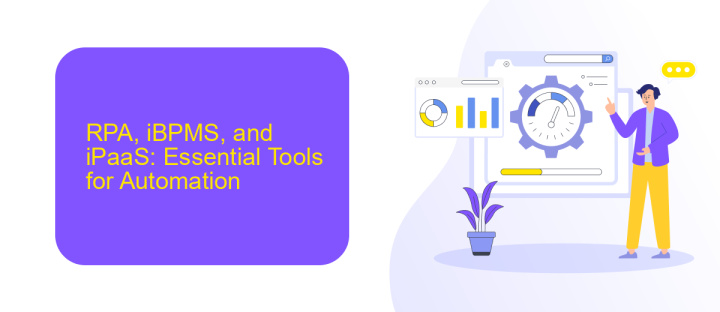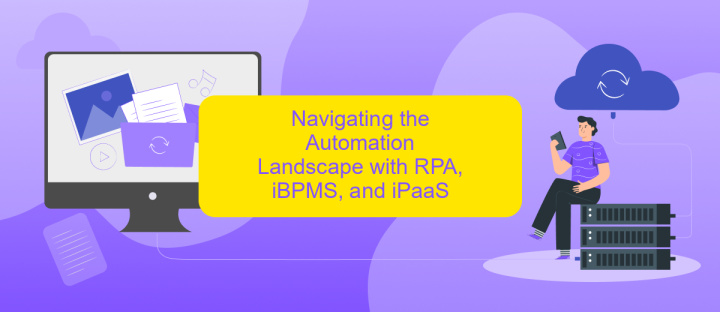Navigate Optimal Routes for Process Automation With RPA, iBPMS and iPaaS
In today's rapidly evolving digital landscape, businesses are constantly seeking ways to optimize their processes and enhance efficiency. Leveraging technologies like Robotic Process Automation (RPA), Intelligent Business Process Management Suites (iBPMS), and Integration Platform as a Service (iPaaS) can significantly streamline operations. This article explores how these tools can be effectively combined to navigate optimal routes for process automation, driving innovation and productivity.
The Need for Process Automation
In today's fast-paced business environment, the need for process automation is more critical than ever. Companies are constantly seeking ways to streamline operations, reduce costs, and improve efficiency. Automation technologies such as Robotic Process Automation (RPA), intelligent Business Process Management Suites (iBPMS), and Integration Platform as a Service (iPaaS) are essential tools in achieving these goals.
- Efficiency: Automating repetitive tasks saves time and reduces human error.
- Cost Reduction: Lower operational costs by minimizing manual intervention.
- Scalability: Easily scale operations without proportional increases in resources.
- Compliance: Ensure processes adhere to regulatory standards consistently.
- Integration: Seamlessly connect disparate systems using platforms like ApiX-Drive.
Utilizing a service like ApiX-Drive can significantly enhance your automation strategy by enabling easy integration of various applications and systems. This not only simplifies data flow but also ensures that all automated processes are synchronized, providing a more cohesive and efficient operational environment.
RPA, iBPMS, and iPaaS: Essential Tools for Automation

Robotic Process Automation (RPA), Intelligent Business Process Management Suites (iBPMS), and Integration Platform as a Service (iPaaS) are pivotal tools for modern process automation. RPA focuses on automating repetitive tasks by using bots, which significantly reduces human error and increases efficiency. iBPMS, on the other hand, offers a comprehensive approach by combining process modeling, business rules, and analytics to optimize and manage complex workflows. Together, these tools streamline operations, allowing businesses to focus on strategic initiatives.
iPaaS plays a crucial role by enabling seamless integration between disparate systems and applications. Services like ApiX-Drive simplify this process by providing user-friendly platforms for setting up integrations without extensive coding knowledge. ApiX-Drive, for instance, allows businesses to connect various software and automate data transfer, ensuring that all systems work cohesively. This not only enhances operational efficiency but also provides real-time data insights, empowering organizations to make informed decisions swiftly. By leveraging RPA, iBPMS, and iPaaS, businesses can achieve a higher level of automation and integration, driving innovation and growth.
Navigating the Automation Landscape with RPA, iBPMS, and iPaaS

In today's rapidly evolving digital landscape, organizations are increasingly turning to automation technologies like RPA (Robotic Process Automation), iBPMS (Intelligent Business Process Management Suites), and iPaaS (Integration Platform as a Service) to streamline operations and enhance efficiency. These tools offer unique capabilities that, when combined, can significantly optimize business processes.
- RPA: Automates repetitive tasks, reducing human error and freeing up employees for more strategic activities.
- iBPMS: Provides a comprehensive platform for managing and optimizing complex business processes, incorporating analytics and real-time decision-making.
- iPaaS: Facilitates seamless integration between various applications and services, ensuring data flows smoothly across systems.
When navigating the automation landscape, leveraging a service like ApiX-Drive can be instrumental in setting up integrations effortlessly. ApiX-Drive allows businesses to connect disparate systems without extensive coding, making it easier to implement and maintain automated workflows. By combining the strengths of RPA, iBPMS, and iPaaS, organizations can achieve a more cohesive and efficient automation strategy.
Case Study: Optimizing Supply Chain Processes with RPA, iBPMS, and iPaaS

In a recent case study, a global manufacturing company sought to optimize its supply chain processes using a combination of Robotic Process Automation (RPA), Intelligent Business Process Management Systems (iBPMS), and Integration Platform as a Service (iPaaS). The company faced challenges in managing inventory levels, order processing, and supplier coordination, leading to inefficiencies and increased operational costs.
To address these issues, the company implemented RPA to automate repetitive tasks such as data entry and order tracking. iBPMS was deployed to enhance decision-making through real-time analytics and process optimization. Additionally, iPaaS was used to integrate various systems and applications seamlessly, ensuring smooth data flow across the supply chain.
- Automated inventory management with RPA
- Enhanced decision-making using iBPMS
- Seamless system integration with iPaaS
By leveraging these technologies, the company achieved significant improvements in supply chain efficiency. ApiX-Drive played a crucial role in setting up integrations, enabling real-time data synchronization between disparate systems. As a result, the company reduced operational costs and improved customer satisfaction through faster and more accurate order fulfillment.
Best Practices for Implementing RPA, iBPMS, and iPaaS
To successfully implement RPA, iBPMS, and iPaaS, it is crucial to start with a clear understanding of your business processes and goals. Conduct a thorough process analysis to identify areas that would benefit most from automation. Engage stakeholders early in the process to ensure alignment and buy-in from all relevant departments. Prioritize processes based on complexity and potential ROI, and create a roadmap for phased implementation to manage resources effectively and mitigate risks.
Choosing the right tools and platforms is essential for seamless integration and scalability. Opt for solutions that offer flexibility and compatibility with your existing systems. For instance, ApiX-Drive can be an excellent choice for setting up integrations, as it allows for easy and efficient connection between various applications without requiring extensive coding skills. Additionally, ensure robust governance and compliance frameworks are in place to monitor and manage automated processes. Regularly review and optimize your automation strategies to adapt to evolving business needs and technological advancements.
- Automate the work of an online store or landing
- Empower through integration
- Don't spend money on programmers and integrators
- Save time by automating routine tasks
FAQ
What is RPA and how does it help in process automation?
How do iBPMS and iPaaS differ in terms of functionality?
Can RPA, iBPMS, and iPaaS be used together for optimal process automation?
What are the benefits of using an integration platform like ApiX-Drive for process automation?
How can businesses determine which processes to automate first?
Time is the most valuable resource in today's business realities. By eliminating the routine from work processes, you will get more opportunities to implement the most daring plans and ideas. Choose – you can continue to waste time, money and nerves on inefficient solutions, or you can use ApiX-Drive, automating work processes and achieving results with minimal investment of money, effort and human resources.


